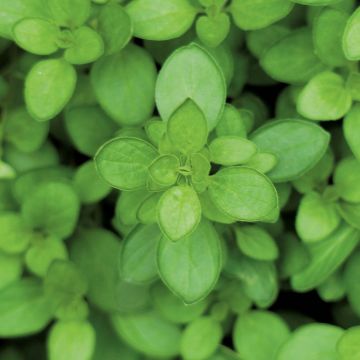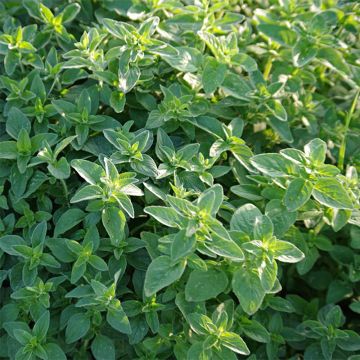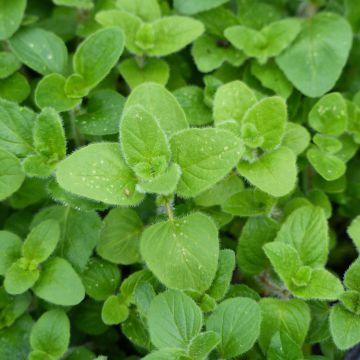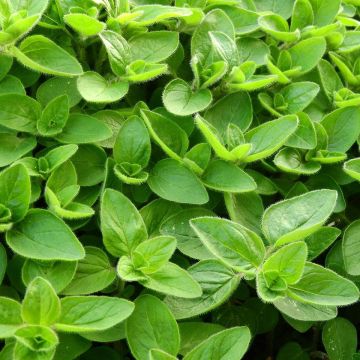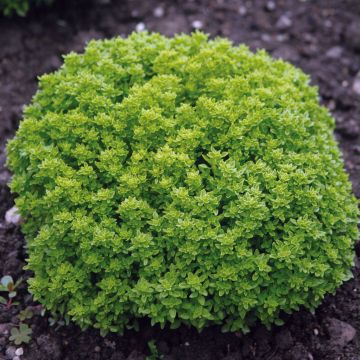

Origan vert ou grec- Origanum heracleoticum (vulgare ssp hirtum)
Origanum heracleoticum - Greek Oregano
Origanum heracleoticum
Greek Oregano, Winter Marjoram
The young plant looked sad upon arrival. Transplanted within 2 days, it eventually thrived exceptionally well (see photo).
Marion, 01/05/2023
This item cannot be shipped to the selected country
Delivery charge from €5.90
More information
Schedule delivery date,
and select date in basket
This plant carries a 6 months recovery warranty
More information
We guarantee the quality of our plants for a full growing cycle, and will replace at our expense any plant that fails to recover under normal climatic and planting conditions.
From €5.90 for pickup delivery and €6.90 for home delivery
Express home delivery from €8.90.

Description
Origanum vulgare subsp. hirtum, also known as Origanum heracleoticum, in French Green Oregano or Greek Oregano, is a subspecies of Common Oregano endemic to the eastern Mediterranean Basin. Used in aromatherapy for its powerful and rare essential oil, this oregano is the most fragrant of all. It is a small bushy plant with green and hairy leaves that offers a beautiful white, fragrant, and honey-bearing flowering in summer. Like all oreganos, this one is planted in a well-drained soil and is resistant to summer drought. Its small aromatic leaves with a deliciously pungent flavour perfume all dishes based on tomatoes, pizzas, but also olive oil, all summer vegetables, grilled dishes, and fish...
Wild Marjoram or Oregano (Origanum vulgare) is sometimes confused with Garden Marjoram (Origanum majorana) but they are two distinct species.
Green Oregano grows spontaneously in Greece and Turkey. In nature, it grows in pine forests, scrublands, and at the edges of cultivated land, on both non-calcareous and calcareous soils, up to 1500m (4921ft) altitude. Its cold resistance is good (-15°C (5°F) at its lowest), but it will be lower in excessively wet soils in winter. This herbaceous perennial plant belongs to the Lamiaceae family, like thyme and lavender. It forms a clump and reaches 40cm (16in) in height and 30cm (12in) in width. This wild Marjoram offers small white flowers during summer. It is a particularly interesting honey-bearing plant to install in the garden. Once well rooted, it does not require watering in summer. The drier the soil, the more fragrant the vegetation.
In the kitchen:
The leaves, added at the end of cooking, are frequently used in tomato sauces and pizzas. They also enhance salads, flavour vinegar and olive oil, pasta and stuffed vegetables, ratatouille, grilled dishes... Infusions can also be made with them. Wild Marjoram is renowned for its antiseptic, analgesic, and antispasmodic properties.
Harvesting: It is done as needed, from May to September. Preferably pick the stems in the morning when the aroma is most pronounced.
Storage: Fresh leaves can be kept in the refrigerator for several days. They can also be dried or frozen. For drying, hang the stems of the wild Marjoram in a bouquet, upside down, in the shade, then store the leaves in airtight containers.
Report an error about the product description
Harvest
Plant habit
Foliage
Other Oregano Marjoram
Planting and care
Green Oregano grows in all types of well-drained soils, as it fears excessive humidity, especially in winter. It tolerates limestone soils well. Plant it in full sun, or in partial shade in our hottest and sunniest regions. Planting is done in spring or early autumn.
In the ground:
The plants should be spaced 30cm (12in) apart in all directions. If your soil is heavy, add gravel and compost and plant in a slightly raised bed. You can also plant oregano between the stones in a rockery. Dig a hole (3 times the size of the root ball), place the root ball and cover with fine soil. Firmly press down and water.
In a pot: Install a layer of gravel at the bottom of the pot to facilitate drainage. Fill it with a mixture of compost and sand, place the root ball and cover with soil. Water regularly, but not too often, without allowing water to stagnate in the saucer.
In autumn, cut back the clump to 15cm (6in) above the ground. Water the young plants until they establish. Afterwards, water only in case of severe drought.
Oregano can be propagated by dividing clumps in spring and by spontaneous sowing.
Cultivation
Care
Intended location
-
, onOrder confirmed
Reply from on Promesse de fleurs
Herbs
Haven't found what you were looking for?
Hardiness is the lowest winter temperature a plant can endure without suffering serious damage or even dying. However, hardiness is affected by location (a sheltered area, such as a patio), protection (winter cover) and soil type (hardiness is improved by well-drained soil).

Photo Sharing Terms & Conditions
In order to encourage gardeners to interact and share their experiences, Promesse de fleurs offers various media enabling content to be uploaded onto its Site - in particular via the ‘Photo sharing’ module.
The User agrees to refrain from:
- Posting any content that is illegal, prejudicial, insulting, racist, inciteful to hatred, revisionist, contrary to public decency, that infringes on privacy or on the privacy rights of third parties, in particular the publicity rights of persons and goods, intellectual property rights, or the right to privacy.
- Submitting content on behalf of a third party;
- Impersonate the identity of a third party and/or publish any personal information about a third party;
In general, the User undertakes to refrain from any unethical behaviour.
All Content (in particular text, comments, files, images, photos, videos, creative works, etc.), which may be subject to property or intellectual property rights, image or other private rights, shall remain the property of the User, subject to the limited rights granted by the terms of the licence granted by Promesse de fleurs as stated below. Users are at liberty to publish or not to publish such Content on the Site, notably via the ‘Photo Sharing’ facility, and accept that this Content shall be made public and freely accessible, notably on the Internet.
Users further acknowledge, undertake to have ,and guarantee that they hold all necessary rights and permissions to publish such material on the Site, in particular with regard to the legislation in force pertaining to any privacy, property, intellectual property, image, or contractual rights, or rights of any other nature. By publishing such Content on the Site, Users acknowledge accepting full liability as publishers of the Content within the meaning of the law, and grant Promesse de fleurs, free of charge, an inclusive, worldwide licence for the said Content for the entire duration of its publication, including all reproduction, representation, up/downloading, displaying, performing, transmission, and storage rights.
Users also grant permission for their name to be linked to the Content and accept that this link may not always be made available.
By engaging in posting material, Users consent to their Content becoming automatically accessible on the Internet, in particular on other sites and/or blogs and/or web pages of the Promesse de fleurs site, including in particular social pages and the Promesse de fleurs catalogue.
Users may secure the removal of entrusted content free of charge by issuing a simple request via our contact form.
The flowering period indicated on our website applies to countries and regions located in USDA zone 8 (France, the United Kingdom, Ireland, the Netherlands, etc.)
It will vary according to where you live:
- In zones 9 to 10 (Italy, Spain, Greece, etc.), flowering will occur about 2 to 4 weeks earlier.
- In zones 6 to 7 (Germany, Poland, Slovenia, and lower mountainous regions), flowering will be delayed by 2 to 3 weeks.
- In zone 5 (Central Europe, Scandinavia), blooming will be delayed by 3 to 5 weeks.
In temperate climates, pruning of spring-flowering shrubs (forsythia, spireas, etc.) should be done just after flowering.
Pruning of summer-flowering shrubs (Indian Lilac, Perovskia, etc.) can be done in winter or spring.
In cold regions as well as with frost-sensitive plants, avoid pruning too early when severe frosts may still occur.
The planting period indicated on our website applies to countries and regions located in USDA zone 8 (France, United Kingdom, Ireland, Netherlands).
It will vary according to where you live:
- In Mediterranean zones (Marseille, Madrid, Milan, etc.), autumn and winter are the best planting periods.
- In continental zones (Strasbourg, Munich, Vienna, etc.), delay planting by 2 to 3 weeks in spring and bring it forward by 2 to 4 weeks in autumn.
- In mountainous regions (the Alps, Pyrenees, Carpathians, etc.), it is best to plant in late spring (May-June) or late summer (August-September).
The harvesting period indicated on our website applies to countries and regions in USDA zone 8 (France, England, Ireland, the Netherlands).
In colder areas (Scandinavia, Poland, Austria...) fruit and vegetable harvests are likely to be delayed by 3-4 weeks.
In warmer areas (Italy, Spain, Greece, etc.), harvesting will probably take place earlier, depending on weather conditions.
The sowing periods indicated on our website apply to countries and regions within USDA Zone 8 (France, UK, Ireland, Netherlands).
In colder areas (Scandinavia, Poland, Austria...), delay any outdoor sowing by 3-4 weeks, or sow under glass.
In warmer climes (Italy, Spain, Greece, etc.), bring outdoor sowing forward by a few weeks.




































